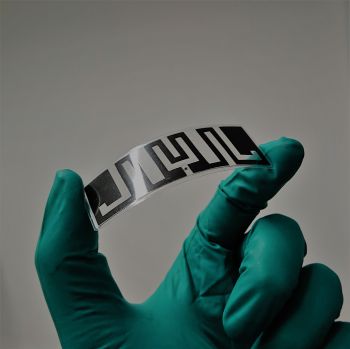
Nanotech inks (credit to Matt Large)
Scientists at the University of Sussex have secured a major cash boost for their research into the real-world applications of nanomaterials. With new funding of £1 million from private company Advanced Material Development, Professor Alan Dalton and his team will pursue their research into nanomaterials, including camouflage technology to stop soldiers from being spotted by thermal imaging cameras or night vision goggles – potentially paving the way for a Harry Potter or Predator-style invisibility cloak.
The team will also develop their research into anti-counterfeiting graphene inks which can be printed onto clothes and medicine containers; incorporated into smart tyres which monitor for problems; used on banknotes; included on metal-free radio-frequency identification tags (RFID) tags for supermarkets to track products; and wearable technology including monitors for babies' heartbeats or diabetic patients' glucose levels.
Carbon based nanomaterials, such as graphene, are metal-free and more ecologically-friendly than many alternatives. They can also be flexible and highly conductive.
Professor Alan Dalton said:
"The funding we've received from AMD means that we can push forward with our research into useful applications for nanomaterials like graphene. Whether that's to develop wearable technology to remotely track babies' heartbeats, or to print ink onto car tyres which can monitor the tyres and warn the driver about problems, the potential applications of these materials are vast.
"One of the most exciting applications is for camouflage clothing which masks the heat or light being emitted from a material or surface. This paves the way for one day making a cloaking device like the one in the movie Predator which lowers its wearer's thermal temperature, or like Harry Potter's invisibility cloak."
The £1 million is split over two years and covers four post-doctorate researchers and various students who will primarily produce nanomaterial inks. The versatile applications include:
Invisibility cloaks for the military and heat-proof windows
When the graphene ink is laid onto a textile or substrate, its reflectiveness can be manipulated. In the laboratory, Alan Dalton's team have been able to control how ions move between graphene sheets which modifies the sheet's optical properties. The team have shown that this works with heat as well as light, recording more than a 5 degree drop in the temperature in the lab. There are clear military applications for this, using a graphene coating to hide the infrared signature of a soldier, or a vehicle. With further development, a soldier's thermal signature could be totally camouflaged to keep them safe from detection at night or from thermal imaging.
The same technology can work on hard surfaces too such as windows. In hot climates it will be possible to cool a room by reducing the amount of heat passing through the window into it, and visa versa in cold weather. Similarly, the amount of light coming into a room could be changed with the touch of a button.
Smart tyres which monitor for defects
The team at Sussex are developing a graphene ink which would be flexible and conductive enough to be printed onto car tyres. It would be able to inform the driver about the health of the tyres. In collaboration with AMD, they are already working with a German automotive company on this technology.
Metal-free tags for supermarkets
AMD and the Sussex team are already working with a major UK retailer on creating metal-free RFID tags for products. They have created an alternative to metal tags on clothing and food by developing antennas based on graphene inks which can be printed onto paper. This will help stores to track their items within supply chains and also to keep more accurate inventories of their stocks within stores. Retailers will be able to bin their metal-dependent tags and replace them with this much more eco-friendly answer. There's no need now for the old fashioned supermarket tags of the past to populate landfill sites. With various supermarkets pledging to improve their green credentials, including Walmart in the US, this technology is set to disrupt this aspect of the retail sector.
Anti-counterfeiting for fashion and medicine
The Sussex laboratory has created a way to incorporate an invisible but unique ink-based signature into textiles and onto hard materials. With this, fashion houses can be sure their clothes are genuinely theirs and not rip-off copies. Hospitals and pharmaceutical companies could likewise be assured of the authenticity of medicines. Even often-stolen items such as metal power line cables could be stamped with the ink so their true origin can be tracked.
Wearable technology for health
The team have also developed a potentially lifesaving baby monitor to track newborns' heartbeats remotely in developing countries where medical centres are sparse. They're now looking to take the developments further including to create printable tattoos for diabetic patients which could track their glucose levels and give them early notice that they are at risk.
Dr Sue Baxter, Director of Innovation and Business Partnerships, said:
"The University is thrilled at the ground-breaking technologies that are bursting out of this university-business partnership. We have such great research capability at Sussex and teaming up with AMD has created a fantastic platform for Alan and his team to get their innovations out of the lab and into our daily lives in a transformational way."
Professor Dalton's team has already created a proto-type capacitive sensor for smart phone screen using silver nanowires and graphene which was both highly conductive, didn't rely on ITO (which maybe facing critical shortage in supply and contains damaging indium) and crucially is also flexible and almost smash-proof.
Advanced Material Development was set up in 2017 to develop applications for graphene technology from Professor Dalton's lab, and is based at the Sussex Innovation Centre. John Lee is the Chief Executive Officer, Dr James Johnstone is Chief Operating Officer and Alan Dalton is Chief Scientific Officer. This is the second grant the laboratory has received from AMD, following £600,000 in Autumn 2018.






